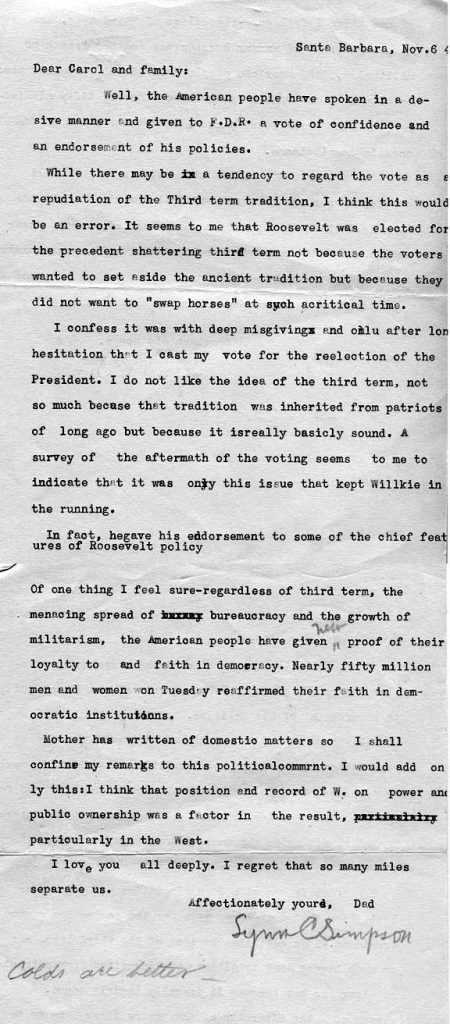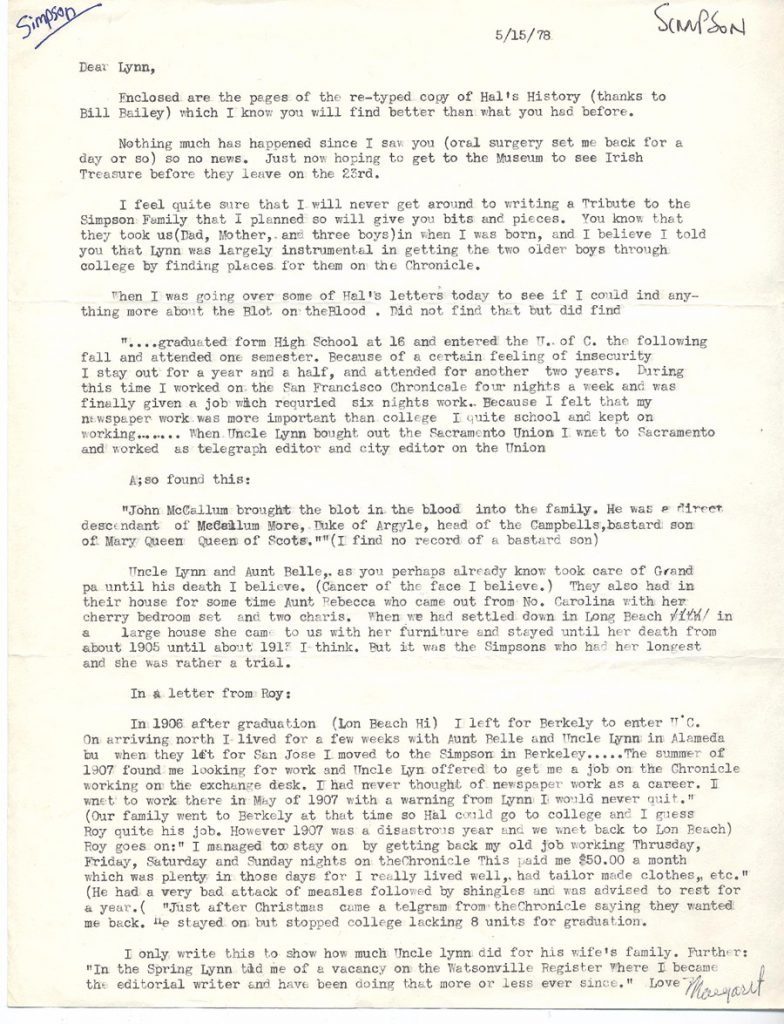1/28/1869 – 7/16/1944

The following biography has been compiled from the notes of Lynn Beedle, Gin Douglas and Jane Hildebrand. Please add any recollections that you might have to make the biography more complete.
Born in Salem, Oregon, January 28, 1869, to Sylvester Confucious Simpson and Mary Frances (McFarland) Simpson. (That was the year the transcontinental railroad was completed at Promentory Point, Utah.) According to Mom, his mother said that he was “her first daughter” because he enjoyed his younger siblings and very often took them out with him when he was going to play with his friends. He often had a young one sitting on his shoulders when he was playing marbles, etc. (Mom said that was why he had a very rounded humped back). I do remember hearing that his playmates were Indian children, and that his father was an “Indian agent”. The family moved to San Francisco, near Mission Dolores, when Lynn was about ten years old. Per Gin Douglas, she thinks Bancroft was responsible for the move to San Francisco, because Sylvester Simpson, Lynn’s father, helped Hubert Howe Bancroft write the Oregon section of Bancroft’s History.
As a boy, he had worked as a telegraph messenger, delivering telegrams on his bicycle.
Lynn’s father, Sylvester, was a friend of the president of the University of Pacific, which was near San Jose, CA. The University of Pacific had an academy associated with the university. Lynn’s older brother Ernest, who was a wild sort, was planning on attending U. of P., so Lynn, who was 14 years old, was sent to the academy to keep his older brother Ernest in line. John Dick Van Eaton, the father of Elizabeth Belle, rented the little house at 817 Myrtle St. in San Jose to seven boys, two of whom were Ernest and Lynn. In college, Lynn played baseball. Apparently he was quite good because his name entered in all 9 positions on a layout of the playing field. There’s a story about his joining with colleagues during Halloween to disassemble the college president’s carriage, putting it into his office piece by piece, and reassembling it therein.
At graduation Lynn was offered a position on the San Francisco city baseball team. He did not accept because he would have had to accept pay for playing on Sunday. Lynn graduated in 1891. After graduation (no family members came to see the graduation). Lynn was supposed to meet the rest of the family and go on a camping trip, but somehow missed them. Depressed, through college, and with no job other than hauling gravel for John Dick Van Eaton, Mammee (Elizabeth Belle) said ” Why don’t we get married”. Lynn left for a while, then came back all dressed up with license in hand and asked, “Are you ready?” Mammee put on her best clothes (black dress) and with her father’s permission they went off to Mr. Oliver, the minister, to get married. Lynn married Elizabeth Belle Van Eaton, Jun 12, 1891, in San Jose, California.
Mammee and Lynn lived with Mammee’s father in San Jose in a house on the corner of University Avenue and Myrtle Street until John Dick Van Eaton died. Daughter Carol Enid was born in this house. They moved to San Francisco, soon after, when Carol Enid was about two, to a little house on Buchanan Street. . Son Ray Venti was born in San Francisco. (A daughter, Jane, died of measles in less than a year. Jane was between Carol and Ray). They then moved back to San Jose and stayed until the earthquake of 1906.
Lynn had wanted to study to become a doctor, but set aside those plans when he married Mammee. When his daughter, Carol Enid, was about eight years old, he attended Cooper Medical School (now Stanford Hospital) for a short time, but could not complete the requirements due to the demands of his job on the Chronicle as Eastern Telegraph Editor.
Lynn joined the San Francisco Chronicle in 1893. (Gin Douglas recalls that he may have worked for the Call Bulletin for a period before joining the Chronicle.) He used to regale us with tales of the Chinese tong wars. He was in the top floor of the Chronicle building during the 1906 earthquake. He told of the building sway being so great that he could look straight out the window and see Market St. come into view ….then disappear. He and a mate had an issue on the paper ready to roll when the fireman drove them out on account of the advancing conflagration. He was at the Chronicle from 1893 to 1913.
Per Jane Hildebrand: “The version of the ’06 earthquake that I remember hearing
is as follows:
When the first quake occurred, Dad decided that he better get out of the building but when he opened his office door, the decorative cornices were flying off the ceiling so he retreated and sat down in his desk chair at which point another quake hit and he and the chair slide across the room. That’s when Market Street came into view. Then he did leave the building and walked up Telegraph Hill (? ask your Mom) and did the burning hotel count. He then went back to the Chronicle building where he and a lino-type man got busy writing and setting type and were about to print their paper when the firemen made them leave. I never heard the bit about buying a horse and buggy but he did buy a bike from a boy for 50 cents.”


During the earthquake of 1906, Lynn worked for the Chronicle in San Francisco, but lived in San Jose. Immediately following the earthquake, Lynn meet Mr. Bean, a previous schoolmate, on the steps of city hall. Lynn said, ” isn’t this awful”, to which Mr. Bean said, “not as bad as San Jose”. Lynn tried to buy a horse and buggy, but everyone else wanted them also. He saw a boy on a bike, gave him fifty cents for it, and started for home. Rode up to top of Mission Street hill and at top of hill looked back and counted 22 hotels on fire. He took the train from San Francisco to San Bruno where there was a large crack in the ground. Changed trains and continued to San Jose. Mammee thought that Dad had undoubtedly died during the earthquake because the news from San Francisco was so bad, so she was amazed when he walked into the yard. The family had set up tents and kitchen in the yard by the time Lynn showed up in the evening. Half the neighborhood slept in their backyard that night, because rumor had it that everyone would be murdered in their beds because Agnews, the insane asylum, had fallen down. First thing in the morning, Lynn took Mammee off in search for food.
Per Jane Hildebrand, “The part about the insane asylum is new to me. The “half of the neighborhood sleeping outside” was probably due to their houses being severely damaged. The “wave” of the quake hit every other block in San Jose, and their house was very badly damaged and had to be partially rebuilt. During the winter Mammee customarily moved the beds down to the library where there was a fireplace. The day before the earthquake Mammee had decided it was time to move back upstairs. By the time the quakes ceased the chimney bricks had cascaded into the library. In order to get out of the house they had to climb out windows because the exit doors were jammed. (check this out with my sisters). I have the impression that they lived in the backyard for quite a while. At some point they rented a house in Alameda and I don’t know how long they lived there.”
Lynn C. Simpson was in San Francisco at least until the time Carol graduated from high school (remember her speaking of “Girls High”).
The family moved to Sacramento in 1913 where Lynn C. Simpson had purchased an interest in the Sacramento Union. Carol (Enid) used to speak of the threats on his life as a result of his editorializing against the “red light” districts and liquor interests. The police chief told him he should carry a gun, but he refused. Per Carol Healy, he actively supported the development of a state highway system for California.As a result of his editorializing against the criminal interests in Sacramento, his paper was effectively blacklisted, and as a result his enterprise failed. Prior to this, the criminal elements of the city had offered Lynn $50,000 to turn his attention elsewhere, but being a man of principle, he refused.
letter from C. M. Goethe regarding Lynn C. Simpson. Apparently while Lynn C. Simpson was owner of the Sacramento Union, one of his goals was to rally against the forces of vice that were rampant in the city of Sacramento. Lynn was offered $50,000.00 (a very large sum in the early 1900’s) if his paper would quit its campaign to rid the city of “commercialized vice”. Lynn refused and ultimately was forced out of business, losing his investment in the paper. He left Sacramento, found work as a “cub reporter”, starting out at the bottom of the ladder. He then went on to complete a very successful career in the newspaper business.
What a wonderful story for the young ones in the family to hear and for us all to be reminded of.
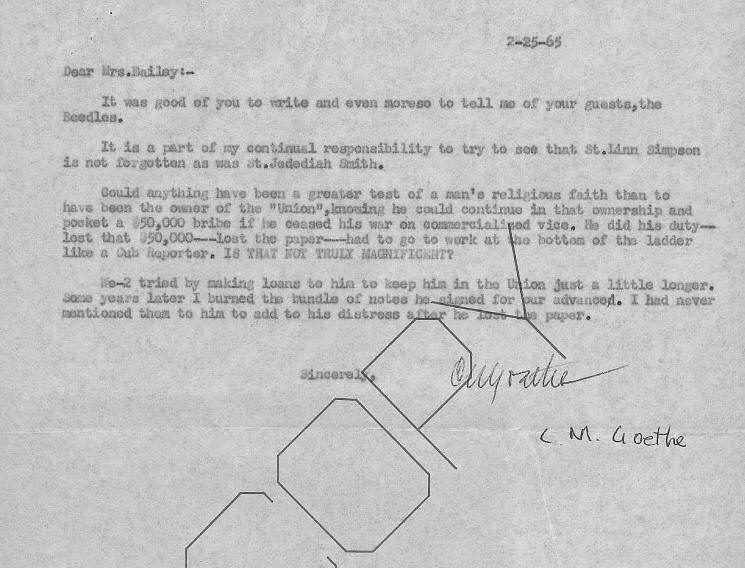
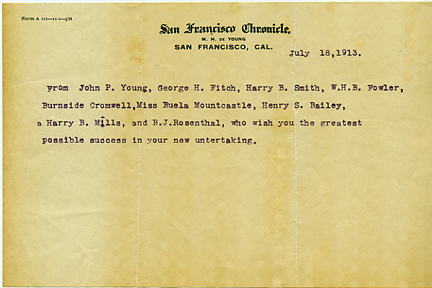
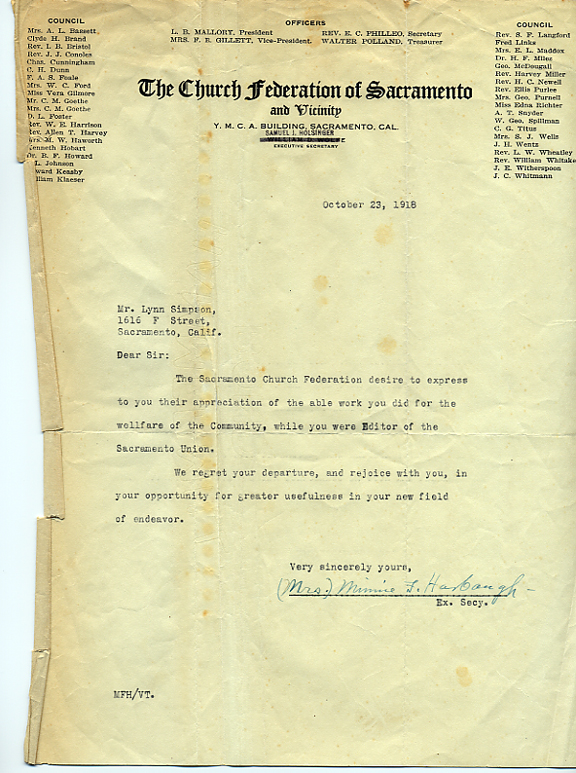


During WW1 he worked for the Food Administration. In 1920 Lynn was appointed to the War History Department of the California Historical Survey Commission, as evidenced by the following appointment:
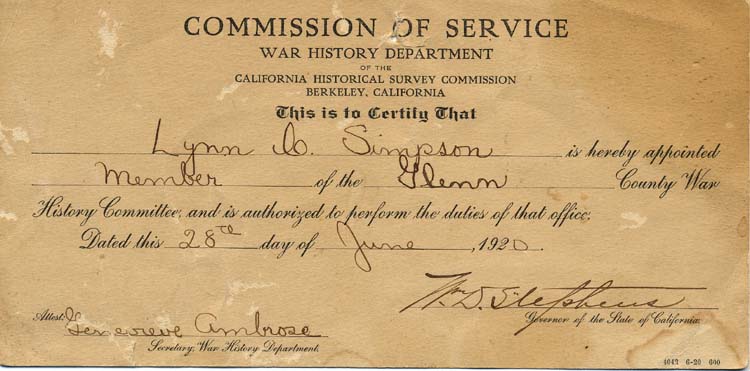
Lived in Berkeley, California from 1920 to 1922, during which time he was employed at (unkown).
Moved to Santa Barbara in 1922-23, where he went to work for Tom Storke, owner and publisher of the then Santa Barbara Daily News. Eventually became the managing editor. (The first job Lynn Beedle ever had where he was paid by check, was working as a copy boy for the Daily News.}
Jane recalls: “Perhaps Mammee and Dad moved to 324 (?) W. Montecito St. before Ray and Cleo were married. In any event Ray and Cleo lived across the street from M & D in a duplex owned by Mrs. Bates before moving to 2401 Chapala. (Note: Mammee was a “moving” force in more ways the one. She had a great business sense, would pursuade Dad to go look at interesting (to her) pieces of property often on the Mesa and sometimes want to buy them, only to have Dad say, “Now, Belle, why do you want to do that?” She would be very
unhappy over his response. [At least once I was sitting at the dining room table with them when this discussion was going on.] She also thought you should always bargain for purchases. She was a frustrated business woman.)



Letters of appreciation from Pres. Elect Herbert Hoover, Community Chest, & American Legion.
Lynn’s recollection: “Lynn and Elizabeth Belle (Mammee) first lived at 2401 Chapala Street. When Ray and Cleo were married and came to Santa Barbara, Lynn and Belle moved to 302 W. Montecito St. (just 3 blocks from the beach).”
Life in Santa Barbara stirs up all sorts of memories for Jane. “I don’t remember the date, but there was an earthquake in Santa Barbara in the early morning while Mammee & Dad lived at 2401 Chapala. Gin and I were sound asleep in a double bed when Dad woke us up saying “we must get out of the house because – – – – “. All the neighbors were in their backyards setting up temporary living areas. Later Dad drove us around downtown so that he could assess the damage. We saw a hotel with one whole side wall gone.”
Eventually left the paper and went into advertising and PR work, mostly for organizations like Community Chest and Red Cross. It was during this period that Lynn Beedle worked for him, typing directly from his dictation.
Lynn Carroll Simpson moved to Mill Valley upon his retirement in 1941 and died in Mill Valley, California, in July 1944, after a fall.
Per Lynn Beedle, “We kids (Lynn, Carol, Gin, Jane, John & Dick) spent a lot of time in Santa Barbara, mostly summers and at holiday time, while we were living in LA, Hollywood, and Glendale. Recollections of 5 o’clock A.M. swimming expeditions….a single square of Hershey’s chocolate (Gin says it was Bishop’s Chocolate) for each of us when the dishes were done….threading the cars into the 2-car garage….waiting in the car while he was putting the paper to bed….occasionally making the hoped-for stop at the ice cream parlor for chocolate-covered ice cream….night trips to Mill Valley. He was always trying out cars for the auto dealers. Nothing but the best: Lincoln, Packard, and most of those trips were to LA and Hollywood to see his family.
A memorable time was the year he had typhoid fever. We stayed in a place that we dubbed “The Mansion”. (A lot of time spent playing jacks.) Visits once a day to sing on the porch where he could hear us. Don’t ever remember seeing him during those illnesses. A favorite then, “Golden Slumbers”.”
Jane’s recollections: ” I think the swimming call was at 6:00 am, and if you agreed to go the night before, you COULD NOT change your mind in the morning just because it was cold and foggy and your wool suit which had
hung out all night was almost dripping. Dad thought it was very important to learn to swim and to learn to drive a car, and he was an excellent teacher. Since I was a “sinker” at the outset and very unsure of myself and the water, Dad bought a pair of water wings and solved the problem. “The Mansion” was up on the Riviera above and part of the posh part of town and was owned by the Mrs. Bates who owned the duplex on Montecito St. It was a pretty dull place for us.We played a lot of jacks, read, wandered through that too big house, etc. Eventually Mom rented a 1 bedroom apartment not far from 324 and very close to the beach where we spent most of our time.”
Gin’s recollections: “The driveway at 324 Chapala Street in Santa Barbara was my training ground for learning to back a car. Mammee did plant her flowers close to those cement strips! It seems to me it was usually a Packard Dad tried out. I do remember one Pierce Arrow. It was in his Lincoln I actually sat in the driver’s seat and drove for the first time someplace along the Rincon? on our way from Glendale to Santa Barbara. How about caramels (Dad’s favorite) and peppermints, sugary and brown striped (Mammee’s choice); I liked one of each at the same time. Didn’t he (Lynn Carroll Simpson) help teach us all to swim? I remember John actually turning blue on a New Year’s Day swim!”
Carol’s memories: During the time Lynn Carroll Simpson was at the “Mansion”, “didn’t we also stay in an apartment closer to the beach for a short time? The apartment had a refrigerator (a first for us) and I experimented with freezing bananas and got sick. Finally we camped in the vacant lot next door to 324 Chapala. Moved to Mill Valley in 1942.”
Note from Lynn Beedle: “Lynn C’s grandson, William Ross Simpson, was killed while on active duty during the Korean war, ending a line of the Simpson name extending back to Lynn C. and perhaps even to Sylvester, his father.”

Newspaper articles and letters pertaining to Lynn C. Simpson:





Notes from a eulogy at Lynn C. Simpson’s funeral service. Author Art Casaday — notes were in Mammee’s scrapbook.




__________________________________________________




